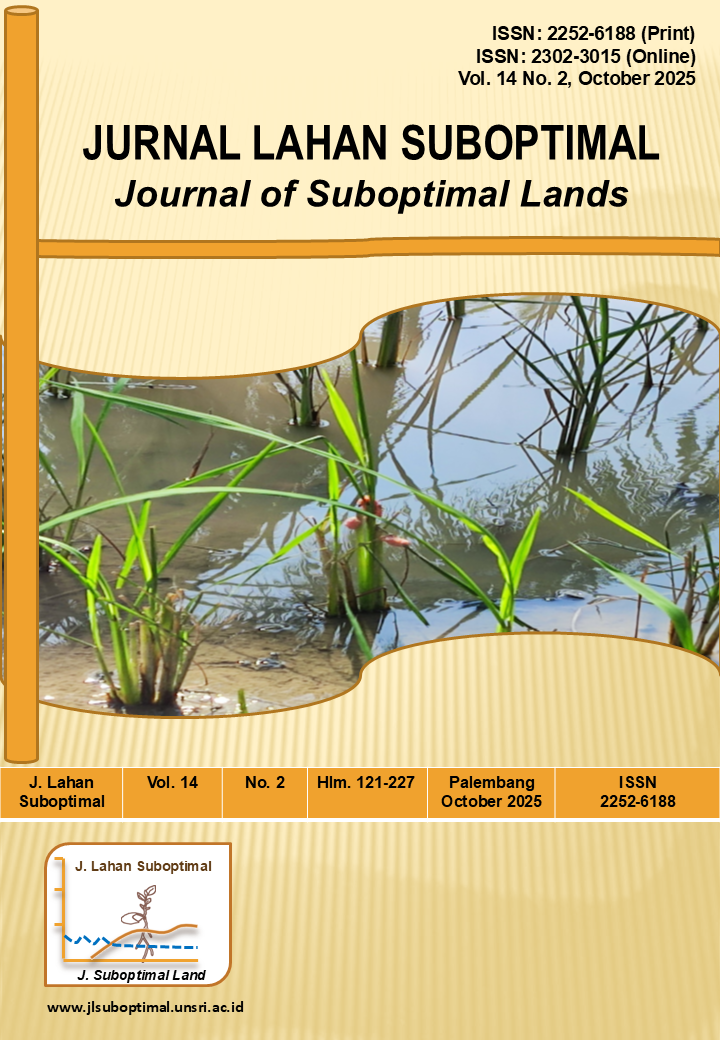Liquid organic fertilizer concentration of pineapple peel on the growth and production of black potato, Plectranthus rotundifolius (poir.) Spreng
DOI:
https://doi.org/10.36706/jlso.14.2.2025.737Keywords:
black potato, growth and yield, liquid organic fertilizer, pineapple peel, sustainable agricultureAbstract
The research aimed to determine the effect of applying liquid organic fertilizer from pineapple peel on the growth of black potato, Plectranthus rotudifolius (poir) Spreng. In this research the method used was Randomized Block Design (RBD) method with six treatment levels, each treatment repeated four times across four blocks, resulting in 24 experimental units. In this study, six treatments were applied, consisting of various concentrations of liquid organic fertilizer from pineapple peel P0 = no treatment, P1= 10%, P2= 15%, P3= 20%, P4= 25% and P5= 30. The research used manure and NPK fertilizer as basic fertilizer in soil planting media. The results showed that the application of pineapple peel had a significant effect on the growth parameters of black potatoes, especially on root fresh weight, shoot fresh weight and tuber volume, treatment P4 (25%) produced the highest shoot fresh weight, average 535.75 g, while P2 the lowest average was 332.25 g, the highest fresh root weight was 18.25 g, while the lowest P1 was 10.75 g and tuber volume had a significant effect on treatment P2 (15%) producing the highest volume namely 4.89 g, while the lowest was 4.10 g. The application of 15% pineapple peel liquid organic fertilizer significantly increased crown fresh weight, root fresh weight, and tuber volume of black potato, while having no significant effect on other growth parameters.
References
Aini, Y. N., Hermiyanti, P., Sulistio, I. (2023). Pineapple peel waste and water hyacinth as Liquid organic fertilizer for the growth of mustard (Brassica juncea L.). In Proceeding international conference on health polytechnic ministry of health surabaya, 2(2), (pp. 1–12).
Altuntaş, Ö., Rabia, K., & Lale, E. (2022). The effect of chicken manure on plant growth nutrient content and yield of lettuce. Science stays true here" Biological and Chemical Research, 9(April), 9–18.
Amanah, S. M. T. H., Budiastuti, S., & Sulistyo, A. (2022). Effect of the media type and auxin concentration on the growth of cuttings seedlings of pepper (Piper nigrum). Cell Biology and Development, 6(1), 32–40. https://doi.org/10.13057/cellbioldev/v060105
Ammanni, S., & Aparanjani, U. (2016). The role of ICT in English language teaching and learning. International Journal of Scientific & Engineering Research, 7(7), 1‒7.
Ciptono, Eko, B., Yoshep, R., & Pragustavi, L. (2022). Liquid organic fertilizer waste painage skin on tomato growth and production in alluvial soil. Agricus: Advances Agriculture Science & Farming, 2(1), 41–45. https://doi.org/10.32764/agaricus.v2i1.2795
Cristina, Esa Frilian, Ismed Inonu, and Nyayu Siti Khodijah. (2022). Utilization of liquid organic fertilizer of pineapple peel waste for shallots cultivation (Allium ascalonicum L.). Jurnal Lahan Suboptimal : Journal of Suboptimal Lands, 11(1), 1–13. https://doi.org/10.36706/JLSO.11.1.2022.570
Dayera, M., Bundaris, P., Febrian, O. (2024). Effect of pineapple peel extracts on organic fertilizer nutrients and growth of cayenne pepper (Capsicum annuum). G- Tech : Jurnal Teknologi Terapan, 8(1), 186–195.
Devaux, A., Ordinola, M., Andrade-Peidra, J. L., Thiele, Graham. (2020). Native potatoes: from forgotten crop to culinary boom and market innovation. Choices, 35(4), 1–7.
Hapsari, N. A. P., & Suparno, S. (2023). Effect of concentration variation of liquid organic fertilizer application on the growth of mustard Plants. Jurnal Penelitian Pendidikan IPA, 9(7), 4894–4900. https://doi.org/10.29303/jppipa.v9i7.2837
Haryanta, D., Tatuk, T. S., & Thohiron, M. (2022). Physico-chemical characterization of liquid organic fertilizer from urban organic waste. Chemical Engineering Transactions, 96(September), 457–462. https://doi.org/10.3303/CET2296077
Hasibuan, A. M., Ferry, Y., & Wulandari, S. (2022). Factors affecting farmers’ decision to use organic fertilizers on robusta coffee plantation: a case study in Tanggamus, Lampung. IOP Conference Series: Earth and Environmental Science, 974(1), 1–8 https://doi.org/10.1088/1755-1315/974/1/012105
Jaseena, P. (2023). Diversity studies in coleus (Plectranthus rotundifolius (Poir.) Spreng.) genotypes based on quantitative traits. The Pharma Innovation, 12(12), 1371–1378. https://doi.org/:10.22271/tpi.2023.v12.i12p.24687
Kurniawan, L., Astuti, E., & Yahya, A. (2024). Optimization of liquid organic fertilizer production from tofu liquid waste using EM-4 activator and additional ingredients of rice washing water and goat urine. Indonesian Journal of Chemical Engineering, 2(1), 1–11. https://doi.org/10.26555/ijce.v2i1.707
Lestari, S. U., & Mutryarny, E. (2020). Using POC azolla mycrophylla and urea fertilizer: lettuce plant (Lactuca sativa L) context. IOP Conference Series: Earth and Environmental Science, 469(1), 1–5. https://doi.org/10.1088/1755- 1315/469/1/012115
Lu, W., Hao, Z., Xiaolong , I., Gao, J., Xiaoqin, P., Gou, J., Li, J., Lin, M., Zhou, Y. (2024). Effects of different proportions of organic fertilizer replacing chemical fertilizer on soil nutrients and fertilizer utilization in gray desert soil. Agronomy, 14(1), 1–13. https://doi.org/org/10.3390/agronomy14010059
Manogaran, M. D., Shamsuddin, R., Hizami, M., yusoff, M., Lay, M., Siyal, A. A. (2022). A review on treatment processes of chicken manure. Cleaner and Circular Bioeconomy, 2(20), 1–13 https://doi.org/10.1016/j.clcb.2022.100013
Muchlisyiyah, J. Teti, E., Dita, P. A., & Hera S. P. (2022). Physicochemical and functional characteristics of black potato (Coleus tuberosus) flour from some locations in east java Indonesia. Advances in Food Science, Sustainable Agriculture and Agroindustrial Engineering, 5(1), 111–120. https://doi.org/10.21776/ub.afssaae.2022.005.01.10
Natasya, C., Safrina, M. E. R., Ningrum, S. E. S., Fitriyani, Zahra, L. A., Ma'arif, B. (2022). B-PORIS: Black potato (Plectranthus rotundifolius) instan porridge as an nutraceutical product. Pharmaceutical Journal of Indonesia, 8(1), 1–7.
Ngadiani, & Andriani, V. (2023). The growth and anatomical response of black potato (Plectranthus rotundifolius) to fermented cow, goat and chicken manure in the lowlands. Journal of Scientific Health 2(2), 65–72. https://doi.org/10.56943/jsh.v2i2.289
Panataria, L. R., Sitorus, E., Sihombing, P., Saragih, M. K., Manurung, I. (2024). Response of pakcoy plant growth and production to the application of poc and manure.”Journal of Agriculture (JoA), 3(2), 67–76. https://doi.org/10.47709/joa.v3i02.3965
Rizar, Fitra Fadhilah, Maria Fitriana, and Teguh Achadi. (2023). “Growth and yield of spinach (Amaranthus tricolor L.) using various compositions of planting media. Jurnal Lahan Suboptimal: Journal of Suboptimal Lands, 12(1), 42–51. https://doi.org/10.36706/JLSO.12.1.2023.585
Seman, N. A., & Adam, S. (2023). The effect of pineapple peel wastes as liquid organic fertiliser on growth character of okra (Abelmoschus esculentus L.). Food Research, 7(1), 70–77. https://doi.org/10.26656/fr.2017.7(S2).7
Sepbrie, M. B. P., & Suparti, S. (2023). Growth of red spinach (Amaranthus tricolor L.) hydroponi uallyusing POC tomatoes and moringa leaves. Bioeduscience, 7(2), 200–208. https://doi.org/10.22236/jbes/11688
Setyawan, D., Maren, A., Budianta, D., Warsito, W., Priatna, S.J. (2022). Liquid organic fertilizer from pineapple peel waste for rural rubber land improvement in west Payaraman, Ogan Ilir. In Proceedings Seminar Nasional Lahan Suboptimal ke-10 Tahun 6051, (pp. 878–84).
Shitophyta, L. M. Ratih, D. L., Maharani N. B. P., & Meilya, S. T. (2023). Effect of pineapple peel extracts on organic fertilizer nutrients and growth of cayenne pepper (Capsicum annuum). G-Tech: Jurnal Teknologi Terapan, 7(4), 1401–1406. https://doi.org/10.33379/gtech.v7i4.3103
Singh, U. P., Ramawatar, M., Basant, K. D. & Raj, K. J. (2021). Use of poultry manure as organic fertilizer in different crops. The Agriculture Magazine, 1(March 2022), 1–3.
Suryani, R., Agusalim, M., Sutikarini. S., & Tamtomo, F. (2022). Utilization of liquid organic fertilizer of pineapple waste to improving growth of sweet corn plant in red yellow podsolic soil. International Journal of Multi Discipline Science (IJ-MDS), 5(1), 30–26.
Sutikarini, S. (2023). Characteristics of wineapple Waste as liquid organic fertilizer and jts effect on ultisol soil fertility. International Journal of Multi Discipline Science (IJ-MDS), 6(1), 38–45. https://doi.org/10.26737/ij- mds.v6i1.3754
Thorat, J. C., & More, A. L. (2022). The effect of chemical fertilizers on environment and human health. ijsdr.org International Journal of Scientific Development and Research, 7(2), 99–105.
Zhou, Z., Zhang, S., Jiang, N., Xiu, W., Zhao, J., Yang, D. (2022). Effects of organic fertilizer incorporation practices on crops yield, soil quality, and soil fauna Feeding activity in the wheat-maize rotation system. Frontiers in Environmental Science, 10(November), 1–13. https://doi.org/10.3389/fenvs.2022.1058071
Downloads
Published
How to Cite
Issue
Section
License
Copyright (c) 2025 Nurlaila Nurlaila, Firdaus Sulaiman

This work is licensed under a Creative Commons Attribution-NonCommercial-ShareAlike 4.0 International License.













